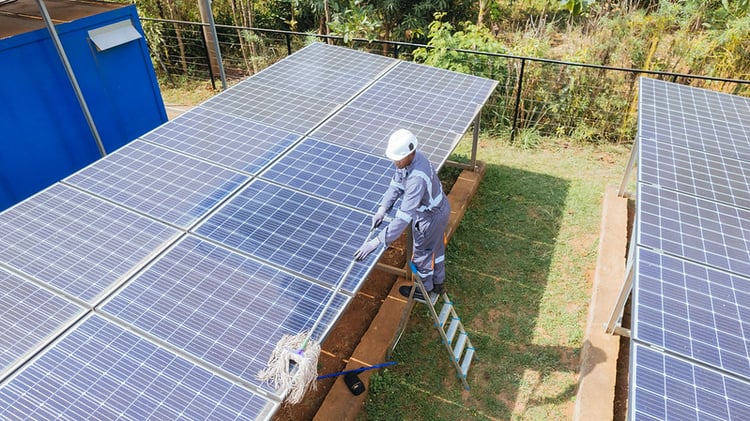Guide
5 simple ways your small business can approach its carbon footprint
Explore how to measure, manage, and improve your company’s climate impact
November 2, 2022
Why do so few companies make an effort to understand and reduce their carbon footprint? It’s easy to blame larger corporations for the bulk of carbon emissions, but small-to-medium enterprises (or SMEs) actually account for 60-70% of the industrial pollution emitted in Europe alone.
While this data is shocking, many SMEs around the globe are likely unaware of their carbon footprint. With limited budgets and less access to resources, smaller enterprises are at a disadvantage in the fight against climate change — no matter how willing they are to take action.
Michelle Haigh Osorio is Investment Director at KawiSafi, an organization investing in clean energy solutions across East Africa. She shared the above statistic during Acumen Academy’s BUILD CLIMATE RESILIENCE Conference panel, “How to Measure – and Lower – Your Business’ Carbon Footprint,” where she and fellow panelists broke down simple ways SMEs can build sustainable business practices to lower their carbon emissions.
“Accept that you’re going to engage on this journey,” says Monique Cooper-Liverpool, who is Managing Director at Petra Resources Inc., a boutique management consulting firm in Liberia and a speaker on the panel.
“Before you get to the tools, make sure everyone is aligned. Bring your full team in as much as possible,” she says. If you’re looking for resources to help align your team, Acumen Academy has team-building courses that can put your group on the right track.
Everybody is not always on board from day one, but I think the reality is that we also accept that we cannot afford to just have people who want to stick their head in the sand and say that they don’t want to do this. Ignorance is no longer acceptable.
Monique Cooper-Liverpool
Managing Director at Petra Resources Inc.
Like most business endeavors, tackling climate change within your company requires putting one foot in front of the other. Below, our Conference panelists break down five simple ways to start reducing your company’s carbon footprint:
- Collect data with industry-approved metrics
- Assess risk and opportunity
- Manage and update technology
- Create employee awareness and engagement
- Involve investors and attract the right audience
Continue reading for the right tips to get you started, and sign up to watch a free replay from Acumen Academy’s BUILD CLIMATE RESILIENCE Conference.
1. Find the right metrics
One of the first steps to reducing your company's carbon footprint is to define it. In other words, what metrics are you using to measure your carbon footprint? Choosing the right metrics will help you gain credibility and build trust with investors and other stakeholders. But it doesn't have to break the bank. Here are some cost-effective resources to help you get started.
The GHG Protocol, or The Greenhouse Gas Protocol, is a widely used standard for reporting emissions and an excellent resource. In their guide, “Understanding Carbon Exposure Metrics,” J.P. Morgan breaks down the GHG Protocol’s list of emissions into three helpful categories:
1. Direct emissions: company facilities and vehicles as well as “fugitive emissions” caused by leaks at enterprises such as coal mines, waste management sites, and any site that deals with gas.
2. Indirect emissions: purchased utilities such as electricity, heating and cooling, and water usage.
3. Indirect value-chain emissions: emissions that happen before or after a value-chain’s activities, including goods and services, employee travel, and product distribution, as well as use of sold products and how they’re disposed of afterwards.
Rosa Castizo is a BUILD Conference panelist and Founder of WAKAYA, which is a food systems environmental impact consultancy group. She recommends checking out the United Nations Framework Convention on Climate Change (UNFCC) as another useful resource for transparent reporting and staying up-to-date on the world’s carbon measurement standards.
What are you eating? My first recommendation is to look at your plate today. Everything you eat has a large carbon footprint. We can change our companies’ and our way of living if we start with ourselves.
Rosa Castizo
Founder of WAKAYA
Similarly, the IRIS Catalog of Metrics is designed to measure the social, environmental and financial performance of an investment and could help you determine the right metrics to track.

Once you’ve identified which kinds of emissions to measure, you’ll want to create an impact measurement framework for collecting and tracking your carbon emission data. Impact measurement is the collection of data to measure, assess, and report on your carbon footprint. Here are four easy steps for implementing your own impact measurement framework:
1. Define what you want to measure. What elements of your company are potentially contributing to its carbon footprint?
2. Select the right metrics. What tools are you going to use to help you measure and track this impact?
3. Collect and analyze data. Once you’ve tracked the data, how will you assess it?
4. Use insights to inform decisions. How will you use the data you’ve collected to lower your carbon footprint?
Defining what you want to measure and designing a framework to help you track your data is an easy strategy to get you started on reducing your company’s carbon footprint.
2. Assess risks and opportunities
Understanding how your business might pose a risk to society and the environment can help you mitigate the future impact of your carbon footprint.
Michelle says, “When you look at your business, there’s probably a set of things that are real risks.[For example], if you’re not disposing of waste properly you could create damage, which means you could have regulatory liabilities.”
Monique explains how one of her clients once relied heavily on diesel generators until discovering the scale at which they were emitting carbon. “Diesel generators are probably the largest single carbon emitter. This is a real problem for Liberia because it powers so much of our energy,” she says.
Her firm discovered that the company’s use of diesel generators was contributing 63 million kilowatt hours of power over the course of one year. “Realizing the scope and scale of their carbon footprint, it became obvious that the urgency was amplified for the company to find more sustainable solutions. We’re currently working with them to find green powered alternatives,” she says.
To assess risks within your own business, Michelle suggests asking: “What things could create large problems for your company, stakeholders, or customers?”
She recommends looking at the International Finance Corporation’s (IFC) Performance Standards, specifically the category on “Assessment and Management of Environmental and Social Risks and Impacts.”
“The IFC has published significant guidance notes for companies on exactly what the important categories [for assessing and managing risks] are, and how to track them,” says Michelle. “ How you assess your company depends on the particular operations of your business.”
She explains how you might approach these Performance Standards:
“You're looking at energy consumption, the type of energy you're consuming, how you're consuming it, opportunities for efficiency, whether the resources you're using are [being applied], opportunities to use resources more efficiently, water usage, generation of waste, and disposal methods of waste.”
Monique also suggests looking at the Equator Principles, another framework that governs large industries and could help you determine, assess, and manage your business’s environmental and social risks.
Once you’ve understood how your business might negatively be impacting society and the environment, you can find opportunities to reduce your carbon footprint. While it may seem overwhelming at first, the steps you take can be small, gradual, and inexpensive. The goal is to better understand your gaps so that you can start making business decisions that prioritize society and the planet.
3. Update technology
Understanding how you’re contributing to climate change may lead you to uncover the elements of your business that are outdated or need changing. This discovery might lead you to consider new technologies that can drive your business towards greater effectiveness and climate-friendliness.
First, consider the kinds of technology you’ve been using across your business including product creation, daily operations, the transportation of goods and services, or other uses. Then assess if or how the adoption of a new technology could help lower your carbon footprint by asking these four questions:
- Is my current technology contributing to or hindering my sustainability efforts?
- Is it outdated or causing inefficiencies that may be contributing to my carbon emissions?
- Are there newer, more efficient technologies or methods I can be using?
- Is my use of technology harming individuals within my supply chain or workforce?

Steven Yeboah is the CEO of Commodity Monitor, which is an organization providing solutions for the natural resource value chain. During the BUILD Conference, he told the story of how a change in technology improved the lives of Ghanaian miners who had been using harmful mercury-based solutions to mine gold.
“If you look at mining communities across Ghana, the impact of mercury is quite tragic, especially on pregnant women and children. For the past decades, all that [these communities] have known is how to use mercury to recover gold,” he says. “We introduced a new technology that is shifting them from the use of mercury, proving that they can still get gold without it.”
We know that climate change disproportionately affects poor and marginalized communities. Gaining a better understanding of your company’s current use of technology can not only help you become more efficient and less wasteful, but can also change the lives of individuals directly impacted by your outputs.
4. Create employee awareness
Oftentimes, the best way to make an impact on the outside is to start by making changes from within. If a technology overhaul is not a viable option for your company, then pause and reflect on how small tweaks to your daily business operations can influence your carbon footprint.
One approach might be to educate your team about small policy changes you’ll be making to reduce your climate impact. Going paperless or holding staff accountable for excess energy uses within the office — such as lights on in an empty office — could be effective ways to start.
“Senior management needs to identify this as a priority, and there need to be people responsible for establishing that process and implementing it,” says Michelle.
Another way to make change from within is to issue a public statement about your commitment to improving your company’s sustainability efforts.This can help you build transparency and accountability, as well as connect you with other organizations sharing a similar journey.
Michelle suggests exploring Climate Neutral, an initiative certifying and helping over 330 brands measure and share their carbon impact. “There are a number of tools across sectors and business types to help capture that [data],” says Michelle.

Lastly, observing the wellbeing of your people is an invaluable step to making positive changes from within. How are the working conditions of your employees? Are their basic rights being covered and is their safety kept in mind? By maintaining a well-managed workplace and employee wellbeing, you can improve the efficiency and overall success of your enterprise while also eliminating excess waste and energy.
“We have a lot of examples of fellows who changed their companies from the inside out,” says Rosa. “In Spain, we have been trying to help companies understand from [within] how to change the systems they have built.”
Changing long standing systems within your organization may feel overwhelming, and perhaps even like an impossibility. Acumen Academy’s free Systems Practice course can help you navigate the process, teaching you how to identify points in the system where you can make the biggest impact and how to develop frameworks for learning and adapting your system over time.
5. Involve investors
“For any company considering raising capital, most investors will have a process to assess how the business is managing environmental risks and opportunities,” says Michelle.
Finding and relying on the right investors to help you manage your environmental impact is a great way to move forward on your climate impact journey. You’ll want to find investors who believe it’s as much their responsibility to lower your climate footprint as it is yours. Identifying the right individuals to join you will require open dialogue and building partnerships based on trust and transparency.
When dealing with stakeholders who don’t see eye-to-eye , Monique suggests taking a human-centric approach. “Try drawing parallels to how this person can personally connect with what’s happening.”
If you have an industry-focused investor, for example, she recommends presenting your climate change initiatives using some of this perspective: highlight what your competitors are doing to combat climate change, or how environmental actions could positively impact the sector.
From our own small corner, we can do much to make sure we have this disaster improved and a responsibility towards the environment.
Steven Yeboah
CEO of Commodity Monitor
Finding and relying on the right investors to help you manage your environmental impact is a great way to move forward on your climate impact journey. You’ll want to find investors who believe it’s as much their responsibility to lower your climate footprint as it is yours. Identifying the right individuals to join you will require open dialogue and building partnerships based on trust and transparency.
When dealing with stakeholders who don’t see eye-to-eye , Monique suggests taking a human-centric approach. “Try drawing parallels to how this person can personally connect with what’s happening.”
If you have an industry-focused investor, for example, she recommends presenting your climate change initiatives using some of this perspective: highlight what your competitors are doing to combat climate change, or how environmental actions could positively impact the sector.
Similarly, if you have stakeholders who are more interested in the financial returns of climate change initiatives, then consider: “What are the opportunities to reduce your costs, use resources more efficiently, and diversify your energy sources? Answering these questions promotes greater predictability and less volatility in your business or can save you costs directly,” says Michelle.

Overall, Michelle suggests asking yourself: “What are the opportunities to connect with your stakeholders, customers, and suppliers in ways that are positive?” Even showing your customers that you’re invested in making an environmental impact can strengthen their loyalty and encourage them to spread the word about your product or service.
Combating the effects of climate change will take all of us — in both small and big ways. Connecting with others, particularly those within our ecosystem, is one way for individual action to become collective action. Don’t be afraid to start having small conversations that could lead to big change.
If you want to learn more about identifying and reducing your business’s carbon footprint, check out some highlights from the 2022 BUILD Conference’s session on “How to Measure—and Lower—Your Business’ Climate Footprint”.
List of Resources Mentioned:
Another course to check out:
Designing for Environmental Sustainability and Social Impact course
Author
Emily Hooper
Emily is a New York City-based copywriter for Acumen Academy. She has explored topics around gender equality, leadership, dignified work, sustainability and more. When she's not writing, Emily is trying new recipes, daydreaming about owning a dog, and creating original media content.



